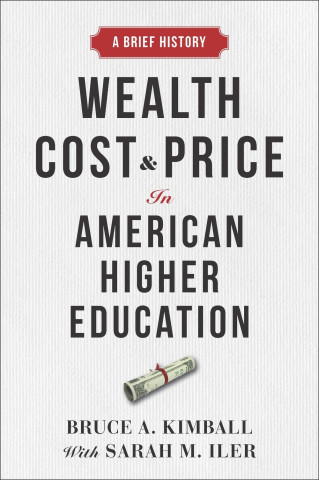
Reviews
Kimball and Iler's richly researched, provocative and pivotally important history of college endowments, campus fundraising campaigns, university finances, institutional spending and student debt.
[Bruce A.] Kimball and Sarah M. Iler explore the historical roots of wealth stratification, lay out the advantages that allow rich universities to get exponentially richer, and propose ways to close the gap with less-wealthy institutions.
Wealth, Cost & Price in American Higher Education: A Brief History, is indispensable and essential for anyone considering the wealthy university's present and future.
This is a timely, well researched monograph....we applaud Kimball and Iler for writing this fascinating backstory to the crisis we now face.
Kimball and Iler have written a book that everyone concerned with university finance in a democracy should read. The United States is currently caught up in concern over the rising cost of higher education; reading this book is the first step toward understanding the problem.
Kimball and Iler's book provides a superb blend of historical and economic analysis of higher education and raises fundamental questions about the equity of educational finance. A major contribution to our understanding of the development of higher education.
Kimball and Iler address the biggest economic questions facing American higher education today. Eminently readable, this is a powerful book, certain to become the new standard in the economic history of higher education.
In clear language that speaks to historians, economists, and general readers, this book explains historically the murky relationship between production cost and students' price in higher education, and how institutional wealth eventually overtook them both.
By far the most comprehensive and sophisticated analysis of endowments in American higher education yet written. A terrific book, impressively clear in discussing the history of higher education finances. A wonderful example of the value that careful historical analysis can bring to policy debate.
Book Details
Preface
Acronyms and Abbreviations
List of Illustrations
List of Tables
Introduction
Part I.: The Formative Era, 1870-1930
1. "Endowment" Emerges, 1870-1930
2. Free-Money Strategy, 1869-1909
3. Birth of the
Preface
Acronyms and Abbreviations
List of Illustrations
List of Tables
Introduction
Part I.: The Formative Era, 1870-1930
1. "Endowment" Emerges, 1870-1930
2. Free-Money Strategy, 1869-1909
3. Birth of the Annual Alumni Fund, 1890-1925
4. Fundraising Drives Begin, 1915-1925
5. Campaigns Proliferate; Presidents Resist, 1920s
6. Did Cost Escalate in the Formative Era?
Part II: The Golden Ages, 1930-2020s
7. Depression, the 60/40 Rule, and Cost-Disease Theory, 1930s-1960s
8. Stagflation, Total Return, and Revenue-Cost Theory, 1965-1980
9. Wealth, Cost, and Price Ignite Resentment, 1980-2008
10. What is the Real "Cost Disease?" 1980s-2020s
11. Steady Price, Rising Debt, Widening Wealth Gap, 2009-2020s
Conclusion: Plato's Descent, Perseveration, and History
Appendices
Index
Notes







